 ElectricalConnection.org
ElectricalConnection.org
Connect with Us:
Facebook
LinkedIn
Twitter
YouTube
ST. LOUIS – A 15-year commitment by Electrical Connection volunteers reached a milestone this year – repairing its 500th low income home for Rebuilding Together St. Louis. And over the years, the effort is a reminder to all residents living in older homes in the area to be aware of issues with aging electrical infrastructure. Included in this year's Rebuilding Together effort were repairs made to a veteran's home. See the complete coverage in the St. Louis Post-Dispatch and KMOV-TV.
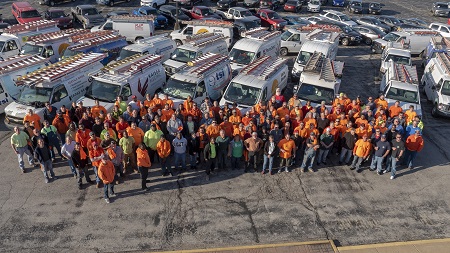
This year, Electrical Connection volunteers began making free electrical repairs on April 28, 2018 to 28 homes for low-income, disabled and elderly St. Louisans. The community improvement effort includes more than 150 International Brotherhood of Electrical Workers (IBEW) Local No. 1 electricians and 20 electrical contractor members of the St. Louis Chapter, National Electrical Contractors Association (NECA). IBEW/NECA form the Electrical Connection partnership.
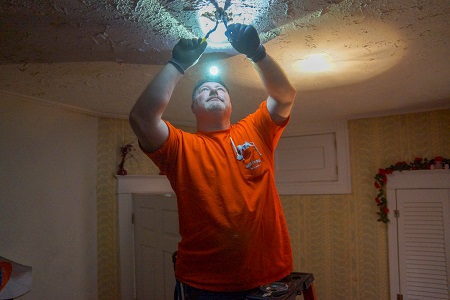
Since 2003, the partnership has donated labor and more than $850,000 in materials to improve more than 520 homes for low-income, disabled and elderly St. Louisans.
“The skills of Electrical Connection volunteers are invaluable to identifying and repairing life safety issues,” said Dave Ervin, executive director, Rebuilding Together St. Louis. “These are older homes with aging electrical infrastructure that may present hidden hazards behind the walls of the homes.”
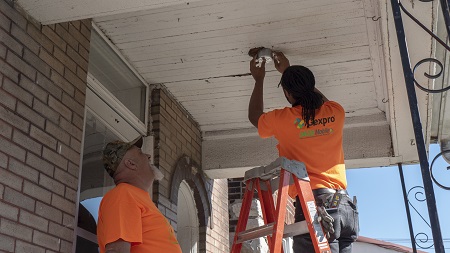
Dave Roth, business representative for IBEW Local 1, organizes the annual safety repairs. He says they often find improper repairs made to the homes by those unskilled in electrical work, creating fire hazards. “It is that ‘quick fix’ with no thought given to safety that often creates the hidden danger,” said Roth. “This includes exposed wires, open splices, overloaded panel boxes and a lack of ground fault circuit interrupter (GFCI) switches and outlets. Repairs require skill and knowledge of the National Electrical Code that IBEW/NECA diligently follow in all its installations.”
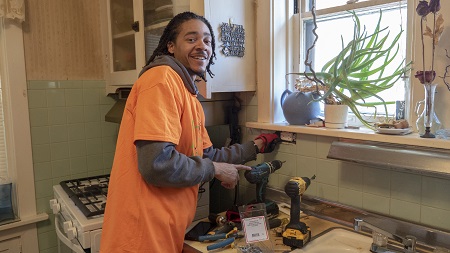
Studies have shown the frequency of electrical fires is higher in homes more than 40 years old. The National Fire Protection Association (NFPA) issued a March 2017 report detailing an annual average of 45,210 U.S. home structure fires reported in the U.S. involving electrical failure or malfunction from 2010 to 2014. The fires resulted in 420 civilian deaths, 1,370 civilian injuries and $1.4 billion in direct property damage each year, according to the report. (see http://www.nfpa.org/News-and-Research/Fire-statistics-and-reports/Fire-statistics/Fire-causes/Electrical-and-consumer-electronics/Electrical).

Because older homes are the dominant housing stock in St. Louis, the Electrical Connection offers the following advice:
· Aluminum wiring was introduced to homes in North America in the mid-1960s as a cost-efficient alternative to copper wiring. Be aware that aluminum is softer and if wrenched into junction boxes and switches can be more easily damaged. It also tends to expand and contract with heat as it conducts electricity causing the wiring to become loose at connections. It is not code compliant in all jurisdictions and should never be integrated with copper wiring. Homeowners need to be a aware that insurance companies charge higher rates in homes with aluminum wiring.
· Knob-and-tube wiring was commonly installed in homes built before 1940. It may still comply with code, depending on the jurisdiction, but it has no grounding wire and connections are not terminated in a junction box. The wire sheathing can decay after many decades of use. The Electrical Connection recommends that knob-and-tube wiring be replaced with modern wiring that meets up-to-date electrical code requirements.
· Flickering lights, switches that feel warm to the touch or buzzing switches can be a sign of a hidden electrical hazard.
· Wiring should always be properly terminated in junction boxes with wire caps securing connections.
· All electrical outlets installed close to a water source (think bathroom, kitchen, laundry area) should have a ground fault circuit interrupter (GFCI)
· Older electrical infrastructure was not designed to handle the load of today’s modern home appliances and technology and is not always suitable to optimized energy efficiencies. A licensed electrical contractor can provide recommendations and install electrical upgrades to meet load requirements. Electrical consumption has increased 70 percent over the past 25 years.
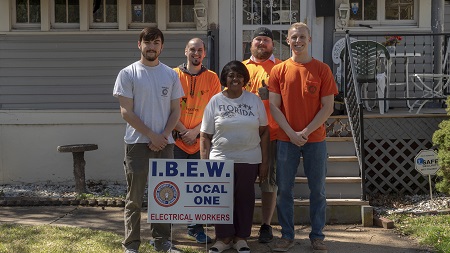
The Electrical Connection offers the largest number of licensed commercial and residential electrical contractors and skilled electricians in the region with a searchable data base at www.electricalconnection.org.
NECA contractors, who donated service trucks and tools in the Rebuilding Together effort, include:
· Bell Electrical
· Benson Electric Co., Inc.
· Branson Electric
· BRK Electrical Contractors, LLC
· Concept Electrical Services, LLC
· Grasser Electric
· House Electric, Inc.
· J Bathe Electric Co.
· Kaemmerlen Electric
· Kaiser Electric, Inc.
· Northwest Electric Co., Inc.
· PayneCrest Electric, Inc.
· Resource Electrical Systems, Inc.
· RJP Electric LLC
· Sachs Electric Company
· Summit Electric
· TSI Group, LLC
· Vision Electric & Systems
· Warren County Electric, LLC.
Members of the Electrical Connection provide safe and reliable electrical construction, maintenance, repair and replacement services across Missouri, the nation and the world.
Recent News